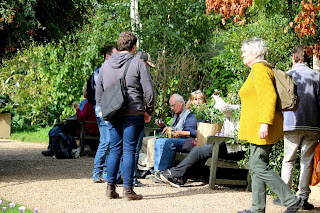To get our new Clearing Spaces Project off to an inspiring start we took a party of volunteers and project participants to Chelsea Physic Garden in London. Where we were able to learn more about medicinal herbs, their use, history and what we might like to include in our new Medicinal Herb Spiral.

Since 1673 Chelsea Physic Garden has occupied four acres of land on the edge of the Thames. First established by the Apothecaries in order to grow medicinal plants, this extraordinary garden in London has had wide reaching impact around the world.
Enjoying a break in the glorious sunshine
As of October 2017, the garden included 5,000 plants, in areas such as:
- The Garden of Medicinal Plants
- The Pharmaceutical Garden, with plants arranged according to the ailment they are used to treat
- The Garden of World Medicine, with medicinal plants arranged by the culture which uses them
- The Garden of Edible and Useful Plants
- The World Woodland Garden
When the Garden was first established by the Worshipful Society of Apothecaries in 1673, its role was to provide a place where they could grow all of the plants which young apothecaries could learn to identify key medicinal plants. This area is an area where apothecaries would have grown medicinal plants in the 17th and 18th centuries. We of course no longer train apothecaries at the Garden, but we are still visited by medical students wishing to learn about the history of plant-based medicine.
Our wonderful guides gave two groups an enjoyable, informative tour of the gardens, paying particular attention to medicinal herbs

The plants are displayed here in a series of themed rooms.
World Medicine Collection
Beds dedicated to medicine throughout every region of the world, some of the plants traditionally used by healers, shamans, witch doctors and herbalists over the last 5,000 years.
Dioscorides Bed
Displays some of the plants first listed by the first-century Greek pharmacologist, physician and botanist Dioscorides (c.40-c.90AD) in his book of medicinal plants.
Officinalis Beds
Early pharmacies were known as officinas and this bed displays the type of plants that would have been sold.
Traditional Medicine of the British Isles
A range of plants grown by the Apothecaries in the Garden between the 17th and 19th centuries are grown here.
Pharmaceutical Plants
Plants form the basis of around a quarter of all modern western medicines. Here each bed represents a different medicinal discipline, including Oncology and Dermatology. There are around 60 plants, all of which are vital to modern medicine.
Herbal Remedies
Displays numerous herbal remedies. Herbal remedies prepared directly from plants are relied on by over 80% of the world's population despite having little scientific evidence.
Some of the group helped choose seed we will grow during the project
and one of our group donated this beautiful rose
Although our time in the garden was relatively short everyone came away feeling refreshed and inspired.














